Imagine the government has hired you to spy and crack down on a group of threatening invaders. As you read the case file, you find your task increasingly daunting. You discover that these invaders — whoever they are — are actually capable of stowing away undetected in cargo that gets shipped across the globe. Furthermore, they actually live inside pieces of dead wood, so you won’t even know they’re there until they suddenly emerge! Who are these mysterious log-dwelling invaders? Who or what are they going to hurt? Are they some kind of alien being? Immediately, your head is swimming with a much more important question: Will I get to meet Fox Mulder? You turn the page in your case file, and are confronted with this picture of your target:
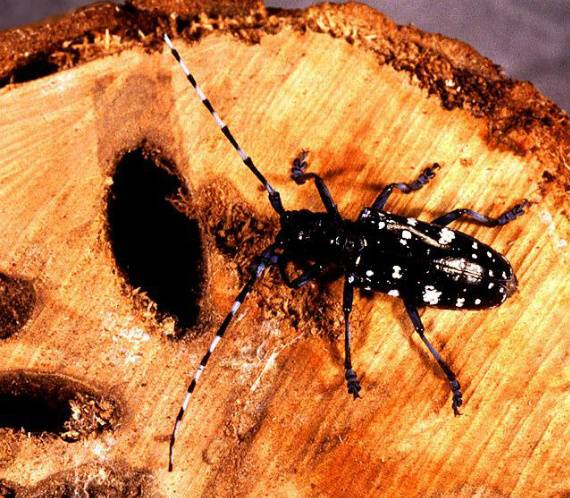
Um. What? A bug? Is this a joke? The remaining pages in the document assure you that it is not a joke. The image is a photo of the Asian Longhorn Beetle (a.k.a., ALB), one of many invasive pests responsible for severe economic damage in the United States. The rest of your file is, fortunately, a five-step guide detailing an approach to dealing with this invasive species and others like it. The steps are:
- Know what’s at stake.
- Know your target.
- Know how the targets communicate.
- Monitor the target.
- Determine potential invader hot-spots.
Step One: Know what’s at stake.
What could be so dangerous about invasive longhorned beetles? Why should you devote your precious time and energy to investigating and stopping these insects? Pests like the Asian Longhorned Beetle damage and kill weakened trees by feeding on them. A recent study estimated the economic damage from wood boring pests like ALB and the infamous Emerald Ash Border to be around $1.7 billion (Aukema, et al.). The cost these beetles inflict is due to decreasing property value and timber value, among other factors. And the beetles themselves are not the only danger. A study published in Chemeoecology shows that invasive wood borers increase the chance that a forest will get hit with fungal diseases (Allison, Borden, and Seybold). Once pest populations are established, they grow fast and are extremely hard to control. Therefore, prevention is key.
Step two: Know your target.
Not all wood-boring insects are bad. You have to know who to look for before you conduct your mission. You discover that longhorned beetles, as the name suggests, have very long antennae. They lay their eggs in wood (usually dead or dying trees), which hatch into larvae, which then mature within the wood before they emerge as adults. There are many different species of longhorned beetles, and Illinois alone is home to close to 100 native species. These native species are not a threat, and can in fact be beneficial to the environment by recycling dead, woody material.
So what makes an animal invasive, and/or a pest? Most simply, an animal is considered invasive when it establishes a successful population in a region to which it is not native (Elton). This can be problematic for the native ecosystem, in part because invasive species sometimes experience a phenomenon known as competitive release. In its native habitat, an invasive species has evolved with other species who compete for the same resources (food, shelter), as well as natural predators. This system of nature’s complicated checks and balances keeps any one species from completely dominating a habitat and decimating the local plants. When an invasive species is particularly successful in a novel habitat, it is often because in the absence of its usual predators and/or competitors, its populations can grow wildly like never before — that is the competitive release phenomenon. Still, the mere fact that an insect is invasive does not always guarantee that it is a significant pest. In order to be considered a pest, it must inflict economic or ecological damage (usually both) where it becomes established.
So now you understand how your targets are different from native species, and why they are dangerous. Here’s another fact: longhorn beetles are a very diverse group, and can look like anything from the picture on the left to the picture on the right:
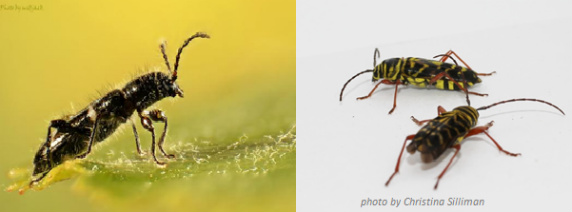
How do you tell who’s who? They don’t wear name tags. For this you will have to bust out your handy-dandy longhorn beetle field guide (yes, this exists) and your keen skills of observation (Yanega). Alternatively, hire a Bug Nerd to do this for you. The Bug Nerd will get some beer money income out of it, and you won’t have to identify dead insects all day. Win-win. If a government employee knows anything, it’s how to delegate.
But here is the real conundrum: how do you find all these beetles in the forest? Spread the word that there’s free pizza by the big old oak tree and see who shows up? That leads you to the crucial third step.
Step Three: Know (and use) how the targets communicate.
If you were trying to spy on humans, you would probably tap their phone lines or hack their internet connection. It’s all in figuring out how they communicate, and then intercepting that communication. But beetles don’t exactly have language, right? You do some research and discover that longhorned beetles actually communicate using a sense of smell to detect special chemicals called pheromones. Pheromones are chemicals released by the beetle that trigger a behavioral response in another beetle. Beetles detect, or smell, these pheromones using special olfactory receptors on their antennae, and follow the scent to its source. Through chemical analysis in the lab, scientists and their minions are able to figure out the composition of these pheromones and synthesize them. If they get it right, the beetles will come to the man-made pheromone just as they would to another beetle calling.
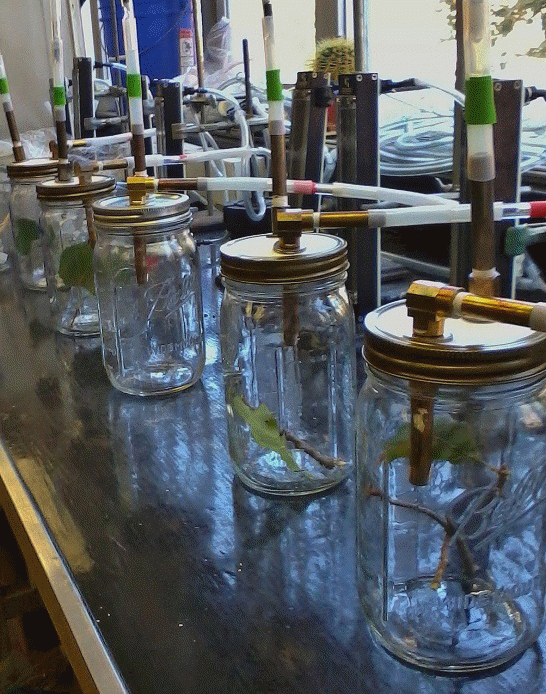
The first step in the pheromone capture and analysis process. The beetles are placed in jars and air is passed over them. When they release a chemical, it is quickly captured in a collection chamber and is ready for analysis via gas chromatography–mass spectrometry (GC-MS).
Using these synthetic pheromones, you will now be able to move on to the fourth step: monitoring.
Step 4: Monitor your target.
You do some digging and discover that in recent years, Dr. Larry Hanks’ lab at the University of Illinois (and collaborators) has developed a relatively inexpensive, user-friendly beetle trap that uses the synthetic pheromone as bait. The lab is happy to collaborate with you and sets you up with some traps and some pheromone bait. By installing these traps in forest patches, you are able to monitor population levels of the different species. This monitoring system should allow for early detection of any potential invading pests.
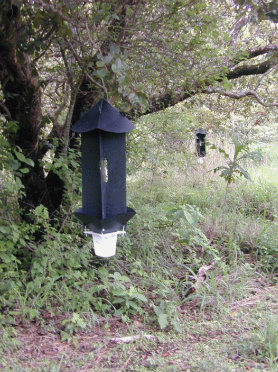
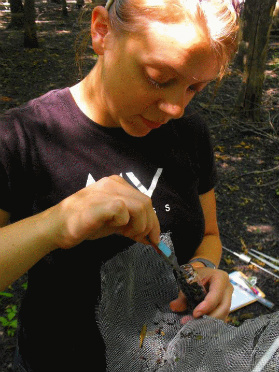 Pictured left: a trap for longhorn beetles, baited with synthetic pheromone
Pictured left: a trap for longhorn beetles, baited with synthetic pheromone
Pictured right: a Bug Nerd collecting beetles from the trap.
Step 5: Zero in on your target’s potential hot spots.
You get a phone call from your supervisor, who sternly reminds you that there is limited funding for pest management research, so you had better become more efficient with your monitoring strategy. Currently you are using traps to monitor longhorn beetles in every possible forest patch, but it will save time and money to monitor only those places where we are most likely to find invaders. You tap into your Bug Nerd network and discover a graduate student at the U of I who is working to figure out which types of longhorn beetle prefer which habitats. It turns out all forest patches are not the same. Some forest patches are large, some are small, some have a lot of dead logs in them, some don’t, some have old trees, and some have young ones. Which longhorn beetles do well in a given forest patch will have a lot to do with these factors.
There are no clear answers at this point (ecologists are always saying that, much to your frustration). The research on which patch types may be most suitable for a potential invader is still underway, and conclusions have yet to unfold. But thanks to your assignment, you have taken crucial and logical steps to intercept invaders, and gained unexpected insight into the world of pest management.
Some hope.
You and the scientific community have expended a lot of time and energy on this matter. Will it even work? Once you know where the hot spots are, what can you do about it? You are relieved to learn that there have been some cases of successful eradication of ALB in North America using a quarantine approach, which unfortunately involves cutting down infested trees, but does help to stop the pest from spreading if it is done effectively (Department of Agriculture & Markets News). Thanks to your five steps, invaders can be detected more quickly and efficiently, and quarantines can be implemented and hopefully minimized in the area.
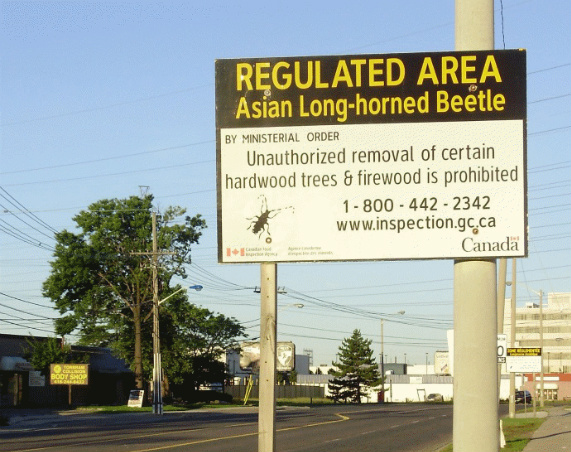
Good work, Special Agent!
For more information on how to be a “beetle buster,” visit beetlebusters.info.
Sources
Allison, J., J. Borden, S. Seybold, Chemoecology 14, 123–150 (2004).
Aukema, Juliann E., Brian Leung, Kent Kovacs, Corey Chivers, Kerry O. Britton, Jeffrey Englin, Susan J. Frankel, Robert G. Haight, Thomas P. Holmes, Andrew M. Liebhold, Deborah G. McCullough, Betsy Von Holle. “Economic Impacts of Non-Native Forest Insects in the Continental United States.” PLoS ONE, 2011; 6 (9).
Department of Agriculture and Market News. “ISLIP, N.Y. DECLARED FREE OF THE ASIAN LONGHORNED BEETLE: Eradication Efforts Demonstrate Success, Additional Areas Targeted.” Press Release. New York State Department of Agriculture and Market News. 2011.
Elton, C.S. 1958. “The ecology of invasions by animals and plants.” London: Methuen and Co. Ltd.
Yanega, D. 1996. Field Guide to Northeastern Longhorned Beetles (Coleoptera: Cerambycidae). Illinois Natural History Survey Research Institute.
Written Linnea Meier, MS candidtate, Department of Entomology.
~~*~~
Smile Politely is proud to introduce a new running series we are calling “Science Politely” that will feature the work of graduate students at the University of Illinois throughout November and December. Working in collaboration with the students in a graduate course in Integrative Biology, Science Politely is a collaboration aimed at bridging the gap between town and university, between scientist and citizen, and between research and culture.








